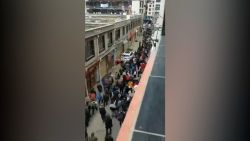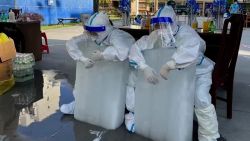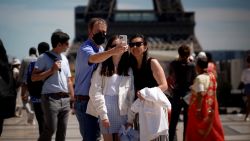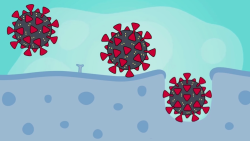A version of this story appeared in the July 24 edition of CNN’s Coronavirus: Fact vs. Fiction newsletter. Sign up here to receive the need-to-know headlines every weekday.
The battle over the United States’ pandemic response, which has been playing out for months in public between President Donald Trump and Dr. Anthony Fauci, moved to a new venue on Thursday: The pitcher’s mound.
The nation’s top infectious diseases expert took a break from fighting the coronavirus crisis to take part in America’s favorite pastime, throwing the first pitch of the 2020 Major League Baseball season at the Washington Nationals and New York Yankees game.
Just hours before Fauci donned a cap, jersey and, of course, a face mask, Trump announced that he had also been asked to throw out a ceremonial pitch at Yankee Stadium next month.
He is the only modern president not to have thrown a first pitch at a MLB game while in office, breaking with a tradition that stretches back to 1910.
Trump said he accepted the offer and asked the Yankees’ president, “How’s the crowd going to be?”
“You don’t have a crowd,” the President said he was told. “There’s no such thing.”
The MLB, like most other sports, is holding games without fans in the stands to avoid spreading the virus; the Nationals’ star left fielder, Juan Soto, missed the opening game after testing positive.
It’s hard to imagine a baseball game without the peanuts and Cracker Jacks, let alone crowds drinking beer and cheering. But you may still be able to applaud or boo players in real time. The league is launching a new feature called Cheer at the Ballpark, which offers fans a chance to participate virtually from home.
Socially distanced workarounds like this may be with us for a long time. Fauci suggested on Thursday that life probably won’t return to normal until well into next year, when we (hopefully) have a safe and effective vaccine.
“If we could vaccinate the overwhelming majority of the population, we could start talking about real normality again,” Fauci said. “But it is going to be a gradual process.”
YOU ASKED. WE ANSWERED
Q: How can I stay safe while playing sports?
A: While most professional leagues aren’t welcoming back fans just yet, some communities are starting to resume sports activities and games. The US Centers for Disease Control and Prevention (CDC) offers these considerations for ways in which youth sports organizations can protect players, families and communities and slow the spread of Covid-19. Administrators should also make sure to consult with state health officials for the most up-to-date and relevant local guidance.
First, assess the risk.
- Lowest risk: Skill-building drills or conditioning at home, alone or with family members.
- Increasing risk: Team-based practice.
- More risk: Within-team competition.
- Even more risk: Full competition between teams from the same local geographic area.
- Highest risk: Full competition between teams from different geographic areas.
Next, try to reduce spread.
- Encourage sick staff, families and players to stay home, especially if they’ve come into contact with a person who has tested positive.
- Promote hygiene (stop spitting on the field!). Teach and reinforce handwashing, and use hand sanitizer when soap and water are not available. Regularly clean and disinfect frequently touched surfaces and equipment, and discourage sharing of items that are difficult to clean, like towels.
- Wear cloth face coverings when physical distancing is difficult, and modify layouts to allow for more space between coaches, spectators and players.
- Try to play outside, or at least in well-ventilated areas.
Send your questions here. Are you a health care worker fighting Covid-19? Message us on WhatsApp about the challenges you’re facing: +1 347-322-0415.
WHAT’S IMPORTANT TODAY
Medical experts urge US to shut down and start over
As the US passed the sobering milestone of 4 million Covid-19 cases, and as the rising daily rate of confirmed cases and hospitalizations suggest the virus is far from under control, medical experts are urging political leaders to shut down the country and start over to contain the pandemic. “Right now we are on a path to lose more than 200,000 American lives by November 1st. Yet, in many states people can drink in bars, get a haircut, eat inside a restaurant, get a tattoo, get a massage, and do myriad other normal, pleasant, but non-essential activities,” the group said in an open letter.
The call comes as Trump canceled Republican convention events in Florida – the clearest example yet of the President bending to the pressures of scientific reality. And the reality couldn’t get more stark: Coronavirus is set to become a leading cause of death in the US, CDC mortality statisticians told CNN.
Microsoft co-founder Bill Gates also sounded the alarm Thursday during a CNN coronavirus town hall. “Infection rates in the US are deeply troubling because the summer, when it’s warmer, when people are outdoors more, actually it’s easier to reduce the infection than it’s going to be out in the fall,” said Gates, who is helping fund the development of coronavirus vaccine efforts. “So we’re in a very tough situation.”
The US response was flawed. But the best-managed nations are seeing big outbreaks too
While the US has come under heavy criticism for its handling of the coronavirus, a number of places that were once seen as the gold standard for pandemic responses are now also seeing surges in cases, as the coronavirus continues to spread around the world unabated.
There’s the outbreak in Victoria, Australia, where military personnel are now being deployed to help track down new infections, following an early response that had kept the virus at bay. Meanwhile, Hong Kong is locking down yet again amid its third wave. And Japan, which has not imposed lockdowns, just recorded its highest daily infection rate yet.
Meanwhile in Europe, Spain, which brought a virulent outbreak to heel this spring with strict measures, is closing down again as infections soar. And the Czech Republic, which held a “farewell party” to the pandemic just weeks ago, is experiencing a new jump in cases linked to a Prague nightclub.
What feels like groundhog day may be our new normal. Even with the most well-intentioned, widespread restrictions, this virus is not going away anytime soon. And, until there is a vaccine, governments may be forced to rely on the strategy of “suppress and lift” – coined by Hong Kong authorities – whereby rules are relaxed and then swiftly reinforced at the first sign of new spikes.
WHO chief to US: Stop making “unacceptable” allegations and focus on “saving lives”
The World Health Organization chief slammed US Secretary of State Mike Pompeo on Thursday for lodging “unacceptable” allegations that the Director-General had been “bought” by China, suggesting that the US should be focused on saving lives instead of politicking, in one of his strongest criticisms of Washington to date.
Pompeo made the claim about Tedros Adhanom Ghebreyesus during a private meeting with British lawmakers in London on Tuesday, Labour MP Chris Bryant confirmed to CNN.
The Secretary of State said there was firm evidence that a deal had been done to put Tedros in the top position at the WHO. When asked to comment on Pompeo’s remarks on Thursday, Tedros said “the comments are untrue and unacceptable and without any foundation, for that matter.”
ON OUR RADAR

- These two tour boats operating at the world-famous Niagara Falls show just how differently Canada and the US are handling the pandemic.
- China has offered a $1 billion loan to Latin America and the Caribbean for access to its Covid-19 vaccine. The country currently has seven candidate vaccines in human trials.
- Brazil has reported yet another new record for infections and is running dangerously low on basic medicine, as President Jair Bolsonaro is criticized for flouting social distancing guidelines despite another positive test.
- A 19-year-old coronavirus patient allegedly raped a 14-year-old girl at a Covid-19 care center in Delhi, India, where an outbreak is pushing hospitals to the brink.
- Face coverings are now required for anyone entering shops and supermarkets in England, as new rules intended to limit the spread of the coronavirus come into force.
- The economic fallout of the coronavirus crisis could spark a “massive” new wave of migration once borders reopen, the head of the Red Cross said in an interview with Agence France-Presse.
- This weekend, as a heat wave bakes huge swaths of the US, experts fear that the collision of Covid-19 and triple-digit temperatures could make an already dangerous situation even deadlier.
- After initially being reluctant to enforce mask wearing, officials in Miami – the epicenter of Florida’s coronavirus outbreak – are now urging residents to keep them on even inside their own homes.
- Less than a month before he died of Covid-19, a New Jersey nursing home worker shared a photo of himself wrapped in what appeared to be makeshift PPE made from garbage bags. His is just one of the many deaths that has gone unscrutinized by the federal government.
TOP TIPS
At this point, we all know we should be wearing a mask when we can’t socially distance, but do you know how many layers it should have?
Home-made cloth face masks likely need a minimum of two layers, and preferably three, to prevent the dispersal of viral droplets from the nose and mouth that are associated with the spread of Covid-19, according to a new video case study published online in the journal Thorax. Reminder: Face masks are thought to protect healthy people from inhaling infectious droplets (dispersed when people are coughing, sneezing or speaking), as well as reducing the spread from those who are already infected.
Researchers used a tailored LED lighting system and a high-speed camera to film the dispersal of airborne droplets while wearing each type of mask. You can watch it here.
TODAY’S PODCAST
“Latinos have always historically had uneven access to critical health [care] and other types of support … but at the same time, we take on the toughest jobs with very little protection.” – Alta-Med Chief Operating Officer Dr. Efrain Talamantes
More likely to be essential workers and less likely to have insurance, the country’s Latino population has been disproportionately affected by the pandemic. CNN Chief Medical Correspondent Dr. Sanjay Gupta speaks to Dr. Talamantes about how Covid-19 has exacerbated those racial disparities to create the perfect storm for the Latino community. Listen Now.
















